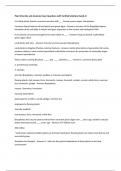Plant Diversity and Anatomy Exam Questions with Verified Solutions Rated A+
First land plants shared a common ancestor with __ - Answers green algae, charophytes
Common shared features of land plants and green algae - Answers structure of the flagellated sperm,
formation of the cell plate in mitosis and gene sequences in the nuclear and cholorplast DNA
First colonist on land are thought to be most similar to ___ - Answers living, branched, multicellular
green algae Chara
Land plants split into: - Answers Vascular and nonvascular (Bryophytes)
Land plants in Kingdom Plantae common features - Answers similar alternation-of-generation life cycles,
produce embryos, have evolved specialized multicellular structures for protection of vulnerable stages
of sexual reproduction
Waxy cuticle covering the plant _____ and ____, solved by ___ - Answers 1. prevents desiccation
2. prevents gas exchange
3. stomata
Sort into Bryophytes, Vascular seedless or Vascular seed plants:
flowing plants, club mosses, ferns, liverworts, mosses, horsetail, conifers, cycads, whisk ferns, mormon
tea, hornworts, ginkgo - Answers Bryophytes:
mosses, liverworts, hornworts
Vascular Seed Plants:
gymnosperms-conifers, cycads, ginkgo, mormon tea
angiosperms-flowing plants
Vascular seedless:
club mosses, ferns, horsetails, whisk fern
Bryophytes and vascular plants evolved from ancestral green algae over __ years ago, seedless vascular
plants dominated earth ____ years ago - Answers 470 million years
300 million
*seed plants replaced seedless plants as dominant land plant, flowing plants are today most diverse and
successful group
Questions for thought; - Answers 1. what are the special adaptations of these plants to the land
environment
,2. how are specialized plant structures related to functions in the land environment
3. what are the major trends in the plant kingdom as plant life evolved over the past 500 million years
4. how has the fundamental reproduction cycle of alternation of generations been modified in
successive groups of plants
All plants have a common sexual reproductive life cycle called ___ - Answers alternation of generation
*plants alternated between a haploid gametophyte generation and a diploid sporophyte generation--
differ by morphology but still the same species
The diploid sporophyte generation is more domination generation for all land plants except - Answers
bryophytes (mosses and liverworts)
List the essential features of the alternation-of-generation life cycle beginning with sporophyte: (120) -
Answers 1. diploid sporophyte undergoes MEIOSIS to produce haploid spores in a protective,
nonreproductive jacket of cells called sporangium
2. dividing by MITOSIS the spores germinate to produce the haploid gametophyte
3. gametophyte produces gamete inside a jack of nonreproductive cells forming
gametangia/gametangium)
4. eggs are produced by MITOSIS in archegonia/ium
Unlike the animal life cycle the plant life cycle: - Answers produces gametes by mitosis, spores are
produced by meiosis
Difference between gametes and spores - Answers gametes fuse with other gametes to form a zygote
and restore the diploid number; haploid spores germinate to form a new haploid gametophyte plant
Major trends in the evolution of this life cycle include: - Answers -increased important of the sporophyte
as the photosynthetic and persistent plant that dominates the life cycle
-reduction and protection of the gametophyte within the body of the sporophyte
-evolution of seeds then flowers
Three phyla of bryophytes - Answers -mosses (bryophyta)
-liverworts (Hepatophyta)
-hornworts (anthocerophyta)
def vascular tissue - Answers specialized cell for the transport of materials
Bryophytes - Answers -restricted to moist habitats for their reproductive cycle
, -remain close to the ground (motile sperm swims from the antheridium to the archegonium and fertilize
the egg
-they have a cuticle but lack stomata on the surface of the gametophyte thallus
-not economically significant except for sphagnum moss (peat moss)
def thallus - Answers plant body that lacks vascular tissue
peat moss - Answers absorbent, antibacterial, used in horticulture and as fuel (store tons of organic
carbon)
-colonize rocks during primary succession
Gametophytes and sporophytes on moss (125) - Answers 1. leafy gametophyte and dependent
sporophytes (elongated structures growing above them) attached, sporophyte developed and matures
while attached to gametophyte (where it receives its moisture and nutrients from)
2. Gametes are produced by the gametophyte in gametangia by MITOSIS, protect gametes
-antheridia (male)
-rosette of archegonia (female)
3. the sperm swim through the film of water to the archegonium and swim down the neck to the egg,
where the fertilization takes place
-diploid zygote divides by MITOSIS and develops into an embryonic sporophyte within the archegonium
-as the sporophyte matures it grows out of the gametophyte (still attached), deriving water and
nutrients
-spores develop by MEIOSIS in the sporangium at the end of the sporophyte; haploid spores are
discharged from the sporangium into a favorable environment, developing into new haploid
gametophytes
*are spores produced by the moss sporophytes formed by meiosis or mitosis? are they haploid or
diploid? - Answers meiosis, haploid
*do the spores belong to the gametophyte or sporophyte generation? - Answers gametophyte
*are the gametes haploid or diploid? are they produced by meiosis or mitosis? - Answers mitosis, diploid
*is the dominate generation for the mosses the gametophyte or the sporophyte? - Answers
gametophyte
Liverworts common features - Answers lobed and flattened body, first group of plants to diverge from
the common ancestor of all land plants




